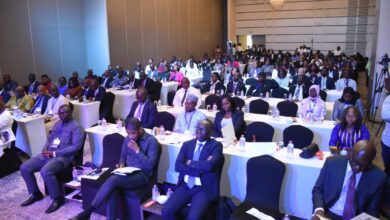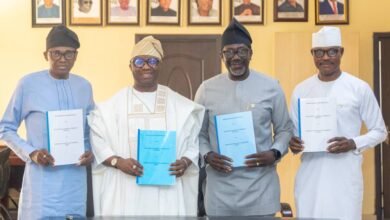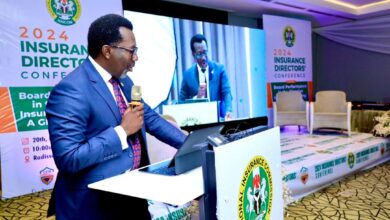IAIS reports shows 35% of insurer investments are ‘climate-relevant’ (2)

By Africa Ahead
SCENARIO ANALYSIS WAS CARRIED OUT USING THE REPRESENTATIVE SCENARIOS DEVELOPED BY THE NETWORK OF CENTRAL BANKS AND SUPERVISORS FOR GREENING THE FINANCIAL SYSTEM (NGFS) TO EXPLORE THE POTENTIAL IMPACT ON THE INSURANCE SECTOR OF ALTERNATIVE POLICY APPROACHES TO CLIMATE CHANGE.
Scenario analysis was carried out using the representative scenarios developed by the Network of Central Banks and Supervisors for Greening the Financial System (NGFS) to explore the potential impact on the insurance sector of alternative
policy approaches to climate change. A scenario with climate change policies pursuing an orderly transition towards internationally agreed climate targets appears to have only limited impacts on insurers’ solvency positions. A scenario with policies that reflect a disorderly transition towards meeting targets or that do not meet the climate targets has more significant effects on the insurance sector. For example, under an orderly transition scenario, results show a drop in insurers’ available capital of around 7% to 8% of their required capital; that drop increases to over 14% under a disorderly transition scenario, and to almost 50% under a “too little, too late” scenario.
Despite the significant losses shown in the four scenarios analysed, the insurance sector as a whole appears to be able to absorb these investments losses, in light of the high pre-stress capital levels. However, these outcomes also partly depend on the scope of the data collected, which cover 53% of the targeted climate data collection (TCDC) sample total assets (general account only). For instance, for the analysis of both climate-relevant exposures and stress scenarios, assets out of scope are not taken into account although they may contain some climate-relevant assets; therefore, the results may not fully re ect the actual impact of the different scenarios.
Over the past few years, a number of private and public initiatives aimed primarily at expanding and strengthening consistent cross-border and cross-sectoral reporting of climate-related risks disclosures have been developed or implemented. At a global level, the Financial Stability Board’s (FSB’s) Task Force on Climate-related Financial Disclosures (TCFD) Framework continues to gather support. However, companies’ disclosure of the potential financial impact of climate change on their businesses, strategies and financial planning remains low (TCFD, 2020).
With speci c reference to the insurance sector, in May 2021 the IAIS and the Sustainable Insurance Forum (SIF) published Application Paper on the Supervision of Climate-related Risks in the Insurance Sector, which provides guidance for supervisors in integrating climate-related risks into their supervision.
AS A NEXT STEP, AND BUILDING ON THE LESSONS LEARNED FROM THIS ANALYSIS, THE IAIS WILL CONTINUE TO IMPROVE DATA AVAILABILITY AND ANALYTICAL TOOLS FOR MONITORING FINANCIAL STABILITY RISKS AS WELL AS TO SUPPORT THE DEVELOPMENT AND SHARING OF GOOD SUPERVISORY PRACTICES AMONG IAIS MEMBERS.
As a next step, and building on the lessons learned from this analysis, the IAIS will continue to improve data availability and analytical tools for monitoring financial stability risks as well as to support the development and sharing of good supervisory practices among IAIS Members.
INTRODUCTION
This is the 2021 special topic edition of the GIMAR. While the regular GIMAR reports on the outcomes of the IAIS’ Global Monitoring Exercise (GME), this special topic edition delves more deeply into the potential impact of climate change on the financial stability of the insurance sector, focusing on the insurer’s investments.
This report contributes to the IAIS’ strategic work on climate risk, which is a key theme of the IAIS Strategic Plan 2020–2024. Scientists are already observing changes in the Earth’s climate in every region and across the whole climate system, according to the latest Intergovernmental Panel on Climate Change (IPCC) Report, released in August 2021. Climate change will lead to more extreme and frequent weather-related events, increasing the physical risks to which insurers are exposed and affecting insurers’ assets and investments, and the insurability of policyholder property and operations. Insurers’ assets and investments are also impacted by the necessary transition to a net-zero emissions economy, especially if the transition is disorderly.
This report is the first global attempt to provide insight into the possible impact of climate change on the insurance sector’s investment portfolio across regions and jurisdictions. The effects of climate change on the investment portfolio vary substantially and may depend on the locations and economic environments of entities, sectors and economies. Based on a unique data collection among 32 IAIS Members (representing around 75% of the global insurance market), this report analyses the size of the insurance sector’s investment exposures to economic sectors and jurisdictions that are more likely to be negatively impacted by climate change.
The analysis is complemented by an exploratory scenario analysis exercise assessing the possible magnitude of risks stemming from these exposures. Finally, the report also includes a qualitative description of possible risks to financial stability as well as an overview of mitigating steps taken by the insurance industry and supervisors.
The analysis provided in this report should be viewed as a step in the IAIS’ work on assessing and responding to climate-related risks in the insurance sector. It is a first attempt to gauge the climate-related risks of the insurance sector’s investment portfolio, to be refined as methodologies develop and more data become available. Undertaking this analysis has been an important learning experience for the IAIS and its Members, and also helps inform the need for further work. The conclusions in this report provide partial and indicative insight into the climate-related risks of the insurance sector.
It is partial as it focuses on investments only and does not examine the impact on liabilities (underwriting) – which is expected to be significant, especially for the non-life insurance sector. It is indicative given the limitations on data availability, the top-down nature of the analysis and the relative infancy of available analytical tools.
Finally, the report does not provide a full global picture on the assessment of risks, but instead provides insights across different regions.
By publishing this report, the IAIS hopes to encourage further work on this area.
- CLIMATE CHANGE AS A FINANCIAL RISK
Climate change is an overarching global threat. It affects human, societal, environmental and economic systems through rising temperatures, rising sea levels, and an increasing frequency and severity of natural catastrophes and extreme weather-related events. Climate change, as well as the global response to the threats posed by climate change (eg the reduction of greenhouse gas (GHG) emissions and adaptation programmes), may have wide-ranging impacts on the structure and functioning of the global economy and financial system.
As such, climate change is a source of financial risk. It may have an impact on the resilience of individual financial institutions, including insurers, as well as on financial stability through physical risks and transition risks. Physical risk refers to increased damage and losses from physical phenomena associated with climate-related trends (eg changing weather patterns or rising sea levels) and events (eg natural disasters or extreme weather).
Transition risk refers to disruptions and shifts associated with the transition to a lowcarbon economy, which may affect the value of assets or the costs of doing business. Important interdependencies may exist between physical and transition risks. For instance, if the transition is slow at first, this may increase the probability that physical risks will materialise. In turn, sharp increases in economic losses from weather-related events may trigger more abrupt policy responses, leading to higher transition risks. In the least favourable scenario, extreme climate-induced damage as a result of long delays in the transition will eventually force a sudden and radical change in the economy.
- SCOPE AND CONTEXT
The scope of the analysis is how insurers’ investments may be negatively affected by physical and/or transition risks. It thereby focuses on the insurers’ assets. The analysis does not assess the potential impact of climate change on insurer liabilities (underwriting), although their relevance is briefly described in a qualitative manner in Section 2. It also does not assess insurers’ exposures to assets that are deemed to contribute to a sustainable transition (sometimes called “green” investments).
The report builds on existing IAIS work on climate risk. In early 2017, the IAIS published a qualitative analysis of the impact of climate change on insurance as part of its 2016 GIMAR. In mid-2018, the IAIS and the Sustainable Insurance Forum (SIF) published Issues Paper on Climate Change Risks to the Insurance Sector.
As the first analysis of climate change risk by an international standard-setting body, this paper provided an overview of how climate change affects the insurance sector and its relevance for insurance supervision. Since then, the IAIS and SIF also published an Issues Paper on disclosures and, most recently, an Application Paper providing guidance to supervisors on embedding climate-related risks into the day-to-day supervision. See also section 5.
This GIMAR special edition complements existing IAIS work by presenting a quantitative analysis based on unique supervisory information provided by IAIS Members, including quantitative information and supervisory assessments of the risks.
The report draws on, and complements, existing work by other international organisations as well as by IAIS Members. In recent years, several international organisations have highlighted the importance of climate change for central banks
and supervisors, including the need for coordinated action to better assess and respond to climaterelated risks. This includes publications by the Bank for International Settlements (BIS, 2020), the FSB and the Network of Central Banks and Supervisors for Greening the Financial System (NGFS). In addition, several IAIS Members have undertaken, or are undertaking, analyses similar to this report.
However, these analyses focus largely on assessing risks within their own jurisdictions. The IAIS’ analysis leverages the experience from Members’ existing efforts and complements it by providing a cross-jurisdictional picture for the first time.
1.3 STRUCTURE
The remainder of this report is structured as follows:
» Section 2 describes how the insurance sector may be affected by climate-related risks and provides insight into the potential financial stability transmission channels
» Section 3 discusses the approach taken in assessing the insurance sector’s investment exposures to climate-related risks and presents the outcome of the data collection
» Section 4 presents an exploratory scenario analysis as a forward-looking perspective on the risks
» Section 5 discusses initiatives and measures taken by the private and public sectors in addressing climate-related risks in the insurance sector (with a focus on risks to insurers’ assets)
» Section 6 presents the conclusions and work planned for the future.
Source Africa Ahead
To be continued





